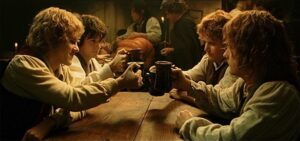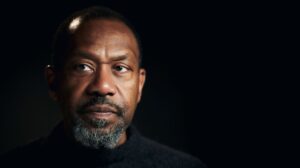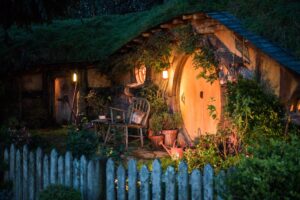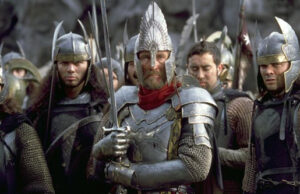Amazon Prime Studios has gone to great lengths to prevent any and all secrets from the set of The Lord Of The Rings from slipping out, and the little marketing they’ve done for the epic fantasy series thus far has been vague and at times misleading. So I have a hard time believing that Sir Lenny Henry, one of the series’ most prestigious stars, was supposed to disclose any information about his role in a recent interview with BBC Radio 4, much less the fact that he’s playing a hobbit.

As you can imagine, the news spread rapidly throughout Tolkien fan-circles. This is the first official confirmation of TheOneRing.net’s exclusive reporting from July that hobbits would be featured in Amazon’s The Lord Of The Rings, and that Henry would be playing one. If Amazon’s series were a straightforward adaptation of The Lord Of The Rings, it would go without saying that hobbits should be present…but it’s not, and that’s why this reveal is causing something of a stir on social media.
Amazon’s The Lord Of The Rings takes place between six-thousand to three-thousand years before The Lord Of The Rings trilogy, during the legendary Second Age of Middle-earth. I’ve written extensively about the Second Age in a series of posts detailing the ancient history of the Elven kingdoms of Lindon and Eregion, the Dwarven mansions of Khazad-dûm, and the Mannish empire of Númenor – but as you’ll find if you look back through those posts, I make no mention of hobbits. And that’s because the diminutive heroes of J.R.R. Tolkien’s books only make their first appearance in the canonical timeline a thousand years after the end of the Second Age.
In the prologue to The Fellowship Of The Ring, Tolkien is intentionally but tantalizingly vague about hobbit prehistory, giving us armchair anthropologists – and the writers for Amazon’s The Lord Of The Rings – extremely little to go on:
“Their earliest tales seem to glimpse a time when they dwelt in the upper vales of Anduin, between the eaves of Greenwood the Great and the Misty Mountains. Why they later undertook the hard and perilous crossing of the mountains into Eriador is no longer certain. Their own accounts speak of the multiplying of Men in the land, and of a shadow that fell on the forest, so that it became darkened and its new name was Mirkwood.”
Thanks to The Tale Of Years in the appendices to The Return Of The King, we can be certain that this “shadow” was in fact the malicious spirit of Sauron, which first settled in Greenwood around Third Age (T.A.) 1050. At this point, hobbits began to migrate steadily westward, and it wasn’t until T.A. 1601 that they crossed the Brandywine River and settled down in what later became known as the Shire. That’s when the hobbits finally began keeping written records of their history, much too late to be very helpful for those of us trying to look back into their distant past.
Even so, it seems clear that hobbits did exist in some form or another during the Second Age. They must have lived in the Anduin river-valley for some time, long enough at least to have become divided into three distinctly separate groups, Harfoots, Stoors, and Fallohides, who crossed the Misty Mountains at intervals between roughly T.A. 1050 and T.A. 1150. Sir Lenny Henry very specifically pointed out that he would be playing a Harfoot hobbit – which is quite interesting, given that Harfoots were the first hobbits to migrate westward. Still nowhere near as early as Amazon’s The Lord Of The Rings is set, but earlier than the Stoors and Fallohides.
Little else is known about these prehistoric Harfoots, except that like all hobbits they originally lived in holes in the ground (a custom which predated the tradition of building large and elaborate hobbit-holes in the Shire), and that they “had much to do with Dwarves in ancient times”. In contrast, the Stoors were “less shy of Men” than other hobbits, and the Fallohides “were more friendly with Elves”. Details such as these could be played up in the series: a Harfoot hobbit being invited into the Dwarven kingdom of Khazad-dûm at the height of its glory would be a moving parallel to Samwise Gamgee’s awe and wonder at that same kingdom’s ruins in The Lord Of The Rings.
But the presence of hobbits in Amazon’s series introduces a couple of complications that definitely can’t be ignored (although there are workarounds). For one thing, there’s a very good narrative and thematic reason for why hobbits don’t start popping up in the legends of Middle-earth until nearer the end of the Third Age. With the exception of people like Gandalf, almost nobody is supposed to know about them.

In The Hobbit, Thorin’s plan to reclaim Erebor only succeeds because the dragon Smaug is unfamiliar with the scent of hobbits. And the entire plot of The Lord Of The Rings hinges on the fact that the dark lord Sauron does not, must not, be aware of hobbits. For they’ve given him no reason to notice them: they’re a small and seemingly harmless people tucked away in a quiet corner of the world, minding their own business and generally not being a bother to anybody. Sauron, seeing only the mighty kingdoms of Men and Elves as his true threats, overlooks the hobbits – allowing them to slip through the cracks in his defenses, undermine his strategies, and eventually defeat him.
So the glaring problem with hobbits in Amazon’s The Lord Of The Rings is that they really can’t do anything of note, certainly nothing that would put them on Sauron’s radar, unless it’s handled very delicately – in the same way that The Clone Wars had to find increasingly complex ways to avoid having Anakin Skywalker and General Grievous ever meet so as to maintain continuity with a single line of dialogue in Revenge Of The Sith.
Thematically, it would also be hard to justify a whole bunch of hobbits going on epic quests to save Middle-earth thousands of years before Bilbo and Frodo’s time. In the prologue to Fellowship, Tolkien does mention that “In olden days they had, of course, been often obliged to fight to maintain themselves in a hard world”, which could provide Amazon’s writing team with an excuse to write about hobbit wars, but the reason hobbits are the heroes of Tolkien’s works is because they’re a peace-loving people put to the test by extraordinary circumstances, not that they were all secretly warriors once upon a time.
If hobbits are a major part of Amazon’s The Lord Of The Rings, then I hope their storyline is more of a survival-genre adventure detailing their trek across the Misty Mountains and Eriador, with their arrival in the Shire moved forward a thousand years or so into the Second Age to give their subplot a clear and satisfying endpoint – preferably marked by the long-expected return of Howard Shore’s Shire theme. Canonically, it’s King Argeleb II of Arnor who grants the hobbits permission to settle there, but it could just as easily be Elendil or Isildur, Aragorn’s distant ancestors.
Would it be fanservice? A little. But that doesn’t have to be a bad thing, and it’s nothing compared to the idea that came to me as I was writing my notes for this post that involves the hobbits helping another enigmatic nature-loving race of people, the Entwives, escape the destruction of their gardens by Sauron and finding a new home for them in the Shire – where Samwise Gamgee’s cousin would one day see a giant elm tree walking across the north moors. Now that’s fanservice, and to be honest I’m not totally opposed to it, either.
Anyway, Amazon obviously has their reasons for including hobbits in The Lord Of The Rings, and I’m sure it has something to do with the fact that hobbits are arguably J.R.R. Tolkien’s most iconic characters, and their absence in his tales of the First and Second Ages is often cited as the main reason why those tales are less widely-known and universally-beloved. But there is some sense in that reasoning. Amidst all the wizards and warriors of Middle-earth, it’s the firmly grounded hobbits whose humility, empathy, and love of nature keeps Tolkien’s epic tales from ever straying into the glorification of war and violence that so much fantasy espouses.
That’s why I don’t necessarily have a problem with hobbits in Amazon’s The Lord Of The Rings. If they have a purpose in the story beyond being instantly recognizable to general audiences, one that doesn’t introduce too many plot-holes but instead uses the hobbits to counterbalance the stories of heroes like Galadriel, Elrond, and Gil-galad, then their inclusion could be quite effective. Ending the series with them finally reaching the Shire after several seasons of hardship, providing a hopeful and optimistic end to Amazon’s story that would offset the tragedies of the Second Age while segueing beautifully into the stories we know, would be very much in the spirit of Tolkien.

And before I end this, I have to address one other thing about Henry’s remarks that isn’t and shouldn’t be a problem – though of course it’s being made into one by bigots. According to Henry, Amazon’s Harfoot hobbits will be a multicultural group including Black actors like Henry himself and Maori actors from New Zealand (making it all the more confusing why Amazon would shift production to the United Kingdom for season two). I’d have supported this casting decision regardless of whether or not Harfoot hobbits were canonically described as being “browner of skin” than other hobbits (which they are, by the way).
So what hobbit-centric storylines would you like to see in The Lord Of The Rings, and how big a role do you think they’ll play in the series? Share your own thoughts, theories, and opinions, in the comments below!





